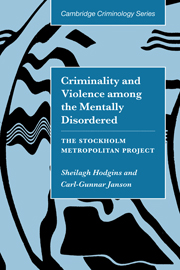Book contents
- Frontmatter
- Contents
- List of figures
- List of tables
- Preface
- Introduction
- Chapter 1 Research on the criminality and violence of the mentally ill
- Chapter 2 The longitudinal approach
- Chapter 3 Swedish society and Stockholm: the cohort and its context
- Chapter 4 Criminality
- Chapter 5 Explanations of the criminality of the mentally ill
- Chapter 6 Early and late-starters
- Chapter 7 Conclusion
- References
- Index
Chapter 3 - Swedish society and Stockholm: the cohort and its context
Published online by Cambridge University Press: 22 September 2009
- Frontmatter
- Contents
- List of figures
- List of tables
- Preface
- Introduction
- Chapter 1 Research on the criminality and violence of the mentally ill
- Chapter 2 The longitudinal approach
- Chapter 3 Swedish society and Stockholm: the cohort and its context
- Chapter 4 Criminality
- Chapter 5 Explanations of the criminality of the mentally ill
- Chapter 6 Early and late-starters
- Chapter 7 Conclusion
- References
- Index
Summary
INTRODUCTION
Every empirical study can be seen as based on a sample of observations in time and space. The phenomena under study occur in a context, which is a more or less unique in time and place, making findings linked to the circumstances of that situation on that occasion. Their meanings and the mechanisms behind them may be generalisable over either wide or narrow ranges of various dimensions, most of them rather vaguely conceptualised.
Swedish Society, albeit narrowed down to the Stockholm community at the time of the cohort, provides the context for many of the studies based on Project Metropolitan data. The general message of this chapter is that certain features of the cohort and its society should be kept in mind, since they may be relevant to the validity, meaning, interpretations and generalisations of the findings of the present investigation. This chapter is an attempt to back up these messages by presenting selected aspects, presumably relevant, of that context. Finally, the cohort itself is briefly described.
POPULATION
Ethnic composition
In their contacts with non-Nordic Europe, Sweden and the other Nordic countries have generally been receiving rather than giving ideas and competence. Urbanisation and industrialisation started late, in Sweden around 1850, but proceeded fast. Also, in about 1850 the huge European, mostly transatlantic, flow of emigration started to be felt in Sweden too. Here it culminated in 1880–93 and subsided after the turn of the century, but the 1930s was the first decade with a small immigration surplus.
- Type
- Chapter
- Information
- Criminality and Violence among the Mentally DisorderedThe Stockholm Metropolitan Project, pp. 53 - 76Publisher: Cambridge University PressPrint publication year: 2002
- 1
- Cited by

